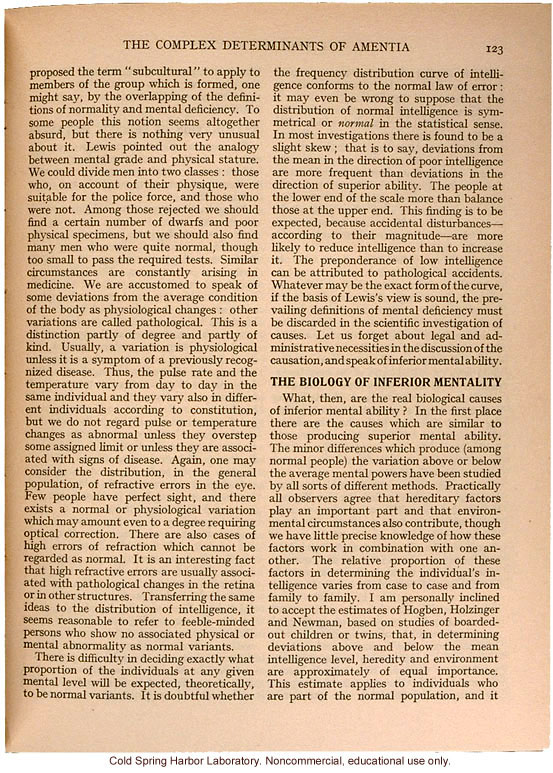The Complex Determinants of Amentia 123
proposed the term "subcultural" to apply to members of the group which is formed, one might say, by the overlapping of the definitions of normality and mental deficiency. To some people this notion seems altogether absurd, but there is nothing very unusual about it. Lewis pointed out the analogy between mental grade and physical stature. We could divide men into two classes: those who, on account of their physique, were suitable for the police force, and those who were not. Among those rejected we should find a certain number of dwarfs and poor physical specimens, but we should also find many men who were quite normal, though too small to pass the required tests. Similar circumstances are constantly arising in medicine. We are accustomed to speak of some deviations from the average condition of the body as physiological changes: other variations are called pathological. This is a distinction partly of degree and partly of kind. Usually, a variation is physiological unless it is a symptom of a previously recognized disease. Thus, the pulse rate and the temperature vary from day to day in the same individual and they vary also in different individuals according to constitution, but we do not regard pulse or temperature changes as abnormal unless they overstep some assigned limit or unless the are associated with signs of disease. Again, one may consider the distribution, in the general population, of refractive errors of the eye. Few people have perfect sight, and there exists a normal or physiological variation which may amount even to a degree requiring optical correction. There are also cases of high errors of refraction which cannot be regarded as normal. It is an interesting fact that high refractive errors are usually associated with pathological changes in the retina or in other structures. Transferring the same ideas to the distribution of intelligence, it seems reasonable to refer to feeble-minded persons who show no associated physical or mental abnormality as normal variants.
There is difficulty in deciding exactly what proportion of the individuals at any given mental level will be expected, theoretically, to be normal variants. It is doubtful whether the frequency distribution curve of intelligence conforms to the normal law of error: it may even be wrong to suppose that the distribution of normal intelligence is symmetrical or [italics]normal[end italics] in the statistical sense. In most investigations there is found to be a slight skew; that is to say, deviations from the mean in the direction of poor intelligence are more frequent than deviations in the direction of superior ability. The people at the lower end of the scale more than balance those at the superior end. This finding is to be expected, because accidental disturbances - according to their magnitude - are more likely to reduce intelligence than to increase it. The preponderance of low intelligence can be attributed to pathological accidents. Whatever may be the exact form of the curve, if the basis of Lewis's view is sound, the prevailing definitions of mental deficiency must be discarded in the scientific investigation of causes. Let us forget about legal and administrative necessities in the discussion of the causation, and speak of inferior mental ability.
The Biology of Inferior Mentality
What, then, are the real biological causes of inferior mental ability? In the first place there are the causes which are similar to those producing superior mental ability. The minor differences which produce (among normal people) the variation above or below the average mental powers have been studied by all sorts of different methods. Practically all observers agree that hereditary factors play an important part and that environmental circumstances also contribute, though we have little precise knowledge of how these factors work in combination with one another. The relative proportion of these factors in determining the individual's intelligence varies from case to case and from family to family. I am personally inclined to accept the estimates of Hogben, Holzinger and Newman, based on studies of boarded-out children or twins, that, in determining deviations above and below the mean intelligence level, heredity and environment are approximately of equal importance. This estimate applies to individuals who are part of the normal population, and it
[end]


